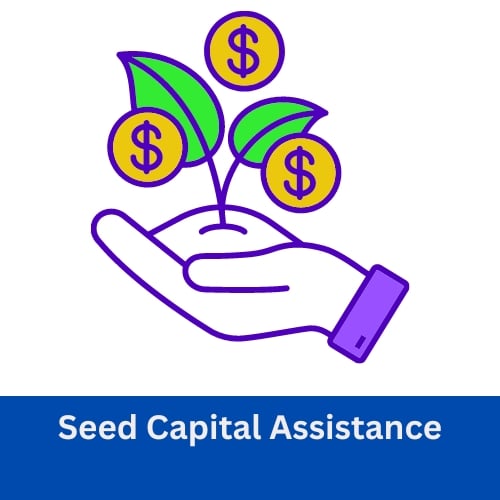Introduction
The presence of seed capital aid in the form of grants, guarantees, and equity financing is actually behind the majority of young entrepreneurs getting their businesses off the ground.
As for small business owners, trying to introduce new and innovative approaches usually implies dealing with the problem of fund acquisition for their ideas to be realized.
Finally, being in a dire financial situation, an aspiring entrepreneur is entitled to relief through seed capital support organizations that provide loans to those who qualify.
In this article, we will be looking into seed capital assistance and everything that it entails.
Seed Capital Assistance

A lot of young guys and girls struggle to start their businesses, even when banks or financial institutions offer to fund their projects.
The main issue is that they can’t come up with the required promoter contribution (margin). To help such persons IDBI has come forward to help the entrepreneurs with a scheme known as Seed Capital Assistance.
The goal of the program is to foster a fresh wave of entrepreneurs who possess the qualities of entrepreneurship but face limitations in terms of their financial resources.
Meaning of Seed Capital
Seed capital, also known as seed money, is the seed capital that a budding entrepreneur needs to set up a new business. Seed is a business that is just starting. Capital is the money that you need at the very start of your business. A ‘budding entrepreneur’ is someone who wants to start a business and wants to make money from it.
But sometimes you don’t have enough money to fund your plan, and that’s where seed money comes in.
Thus, seed capital refers to the initial capital that is required to obtain loans from financial institutions (promoter’s contribution). Seed capital is a portion of the equity. It serves as an incentive to enter into industry. The seed capital helps entrepreneurs who do not have sufficient funds to start the industry.
Eligibility Criteria for Seed Capital Assistance
To qualify for assistance, entrepreneurs must have technical or professional qualifications, relevant experience, or skills in industry, business, or trade.
Entrepreneurs falling under these categories are eligible for support through the program:
- New-generation entrepreneurs on a small scale require seed capital of more than * 4 lakhs.
- Small business owners looking to grow their business through expansion, diversification, or modernization.
- Entrepreneurs who are looking to move up from the small scale to the medium sector for the first time.
- Entrepreneurs planning to start a project in the medium sector for the first time.
- Entrepreneurs who are already operating in the medium sector and are considering diversification to improve their viability.
- Entrepreneurs seeking additional seed capital to meet project cost over-run, caused by factors beyond their control.
- Entrepreneurs planning to acquire a struggling or closed business. Projects constituted as public/private limited companies or partnership/proprietary concerns are eligible for assistance.
Amounts and Mode of Assistance
The amount of seed capital assistance for the project shall not exceed 15 lakhs. However, the actual amount will be determined based on the gap in the equity required for the project as well as the shortfall if any in the prescribed minimum promoter’s contribution after considering his contribution and from other sources and subsidies and incentives.
To determine how much help to give, we will use a debt-equity ratio of 2:1 for small-scale units and 1.5:1 for medium-scale units. The assistance will be in the form of soft loans in the case of proprietary and partnership concerns.
In the case of private limited companies, the assistance will be by way of soft loans of subscription to 1% cumulative redeemable preference shares. In the case of public limited companies, the assistance will be normally by way of subscription to equity capital or cumulative redeemable preference shares (at 1%) or both or by way of a soft loan.
The soft loan would be interest-free which will carry a service charge of 1% per annum. However, IDBI might have the choice to apply a different interest rate on the soft loan. There is no commitment charge. The length of time you have to pay back the loan is based on how much you can afford to repay, starting with a grace period of up to 5 years. New security except the personal guarantee of the promoter is stipulated.
Application Process:
- Ensure that you are eligible for the Startup India Seed Fund Scheme, including age and sector restrictions.
- The Startup India portal has an online application call regularly for prospective entrepreneurs.
- DPIIT-approved startups can apply for the purpose via the official Startup India portal.
- Go to the Startup India Seed Fund Scheme website and click on “Apply Now” to apply online.
- You can also apply through an incubator. Find an incubator that is affiliated with the Seed Fund Scheme and submit your application through them, as direct applications are not accepted.
- Create a comprehensive business plan outlining your startup’s value proposition, market potential, financial projections, and how the seed fund will be utilized.
- Be prepared to pitch your startup idea and present your business plan to the incubator for evaluation.
- Your application and business plan will undergo a due diligence process by the incubator, focusing on viability, scalability, and team capability.
- Upon successful evaluation, receive approval and subsequent disbursal of funds according to the terms laid out by the incubator/Scheme guidelines.
Startup India Seed Fund Scheme Eligibility
For Startups
- A firm with a DPIIT identity and less than 2 yearly age brackets of establishment at the time of funding application.
- To get DPIIT-recognized, please visit Startup Recognition & Tax Exemption
- For a startup, it is necessary to have a key idea of the creation of a product or service that the market strives for and this business idea must be based on the assessment of the possibility of distribution at the expense of any potential risks and market demands and the ability of its scaling.
- The startup is supposed to create a new innovative product offer a new business approach, optimize the distribution model, or apply a new methodology to solve a problem of an existing company in the market.
- The expected startups are those who can create unique products in areas involving social well-being, candle burning, water purification, micro-finance, education, agriculture, food processing, biotechnology, personal care, electricity, transportation services, defense, space technology, railways, oil and gas, textile, etc.
- In different initiatives, of other Union and State Government schemes, the Startup clearly should not have received more than Rs 10 lakh of monetary assistance. However, earnings from competitions and grand challenges, working place gratuity, monthly allowance of the founders, the laboratory, and prototyping facilities are all a part of the agreement.
- The shareholding of Indian promoters in the startup at the time of application to the incubator should be at least 51% considering that the Laws and Regulations of the SEBI (ICDR) Act, 2013 and SEBI (ICDR) Regulations, 2018, are hereby into account.
- Benefits from counterpartic capital are obtained in the form of both grants and traditional debt/convertible debt with the corresponding policy framework for the scheme.
For Incubators
- The incubator must be a legal entity:
- The fortnightly journal is a registered society under the Societies Registration Act 1860, or.
- A Trust as Buckley described in the Indian Trusts Act 1882, or
- A company Private Li’d registered under the Companies Act of 1956 or the Companies Act of 2013, or the OTT services is under the Ministry of Information & Broadcasting of the Government of India.
- A legally formed organization composed of lawmakers by way of passing an Act in the lawmaking body.
- The incubator should be running for a minimum of two years on the date the application is received by the plan.
- At least 25 seats must be installed and the incubator must have amenities that allow individuals to gather there.
- A minimum of 5 startups (physically located) in the incubator are under incubation terms on the application date.
- The incubator must have a permanent chief executive officer with business development and entrepreneurship experience. He/She will be aided by a capable team who will be assigned the mentorship activities in ideas testing and validation. Also, the team will be responsible for legal, finance, and human resources support.
- The incubator must not be obliged to provide an incubator with seed investment that was provided by any external private financing channel.
- The irony is that the Incubator ought to have been taken care of by the Central/State Government(s)/Central/State Governments(s)
- In case the incubator has not been assisted by the Central or State Government(s)
- The incubation should be initially up and running for three years at least before further steps can be initiated.
- There must be 10 independent startups within the incubator’s space in operation. The due date should be indicated while submitting the application form.
- Must be audited and publicized the past two years’ financial reports.
- Moreover, such EAC members may at times increase the final score based on their criteria.
Features of the Scheme:
- “Call for Applications” for both incubators and startups ongoing year-round.
- Sector-agnostic program.
- No need for maintenance of the physical embodiment.
- Entrepreneurs can apply to a maximum of three suitable incubators at any given time.
Incubator Requirements:
- The incubator startup should go live within 2 years.
- There should be a seating capacity for at least 25 people.
- At the time of application, we should have at least 5 startups approved for the incubation physically.
Timeline:
- The scheme was launched on April 19th, 2021.
- It takes a few weeks or months based on your application
Alternatives to Seed Capital Assistance:
1. Angel Investors:
- Wealthy individuals who invest their own money in promising startups in exchange for ownership equity (a percentage of the company).
Pros:
- Offer valuable mentorship and industry connections besides capital.
- More flexible than VC firms and may be open to high-risk, high-reward ventures.
Cons:
- Can be selective and require a strong pitch and business plan.
- You relinquish some ownership and control over your company.
2. Crowdfunding Platforms:
- Online platforms that allow you to raise capital from a large pool of individuals, typically in exchange for pre-orders, rewards, or equity.
Pros:
- Excellent way to validate your concept and gauge market interest.
- Democratizes fundraising, allowing anyone to contribute.
Cons:
- Requires significant marketing effort to reach a wide audience.
- Success depends heavily on a compelling campaign and product.
3. Government Grants:
- Financial assistance is offered by government agencies to support specific sectors or encourage innovation.
Pros:
- Often non-dilutive (doesn’t involve giving up equity).
- Can be a significant source of funding for startups with socially impactful ideas.
Cons:
- The application process can be lengthy and competitive.
- Grants often come with specific use restrictions.
4. Bootstrapping:
- Financing your startup using personal savings, revenue generated by the business itself, or creative strategies like bartering or pre-selling products.
Pros:
- Retains complete ownership and control of your company.
Cons:
- Slower growth due to limited funds.
- Requires careful financial planning and resourcefulness.
5. Pre-Sales or Pre-Orders:
- Generating initial capital by taking orders or selling products before they are even produced.
Pros:
- Validates market demand and creates early customer buzz.
- Provides immediate working capital.
Cons:
- Requires a well-developed product concept and strong marketing strategy.
- May require fulfilling orders before receiving full payment.
6. Incubators and Accelerators:
- Programs that provide startups with mentorship, workspace, access to investors, and other resources in exchange for a small equity stake or fees.
Pros:
- Valuable network and support system for early-stage businesses.
- Structured program to help refine your business model.
Cons:
- Competitive selection process.
- This may require relocating to the incubator/accelerator location.
Real-life examples From Seed Capital Assistance
- Steve Jobs and Apple:
- In the early days of Apple, Steve Jobs and Steve Wozniak received seed capital from angel investor Mike Markkula. Markkula’s investment of $250,000 helped Apple kickstart its journey, leading to the creation of iconic products like the Macintosh and iPhone.
- Google:
- Larry Page and Sergey Brin, the founders of Google, initially received seed funding from Andy Bechtolsheim, co-founder of Sun Microsystems. Bechtolsheim wrote a check for $100,000 to “Google Inc.” even before the company was officially incorporated. This early investment played a crucial role in Google’s growth and eventual dominance in the search engine market.
- Facebook:
- Mark Zuckerberg famously received seed capital from Peter Thiel, co-founder of PayPal. Thiel invested $500,000 in Facebook during its early days. This infusion of capital allowed Facebook to expand its user base and develop its platform into the social media giant we know today.
- Airbnb:
- Airbnb founders Brian Chesky, Joe Gebbia, and Nathan Blecharczyk struggled initially to secure funding. However, they received seed capital from Paul Graham’s Y Combinator accelerator program. The $20,000 investment helped Airbnb refine its business model and gain traction in the competitive hospitality industry.
- WhatsApp:
- Jan Koum and Brian Acton, the creators of WhatsApp, received seed funding from Brian Acton’s former Yahoo colleague, Michael Yavonditte. Yavonditte invested $250,000, which allowed WhatsApp to focus on growth and user acquisition. Eventually, Facebook acquired WhatsApp for a staggering $19 billion.
Conclusion
Seed capital is the starting point for your ideas and business ventures. Through understanding the requirements, procedures for application, and benefits of the assistance programs for seed capital, it will be possible for you to decide whether these financial resources are appropriate for your start-up.
However, even if it isn’t the perfect option, don’t feel troubled – numerous other financial sources can still be followed through. It is not necessary to neglect the strategic planning and creative elements for the gathering of funds and other necessities to get started on the entrepreneurial path.











1 Review